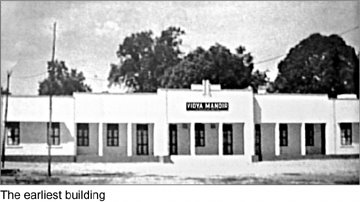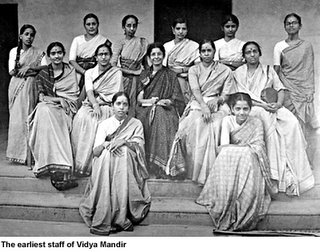Vidya Mandir: school which started with a single classroom
When two convents in the city decided they would do away with boys, desperate parents of some of these children looked for options. The Mylapore Ladies Club came to their rescue.
Contributed by Ashwin Prabhu

It is said ‘Necessity is the mother of invention’.
Indeed, it was the sheer necessity for a quality, English-medium school for boys, that led a small group of anxious parents from Mylapore to lay the foundation for what is today ‘Vidya Mandir’, a much-reputed co-educational school in Mylapore, Chennai.
It was the fag end of the academic year in January of 1956, when acclaimed convent schools in the city like Church Park-Presentation Convent on Mount Road and Rosary Matriculation in San Thome decided that they would not admit boy students into their schools, and asked them to leave with immediate effect.
The first step
Deeply concerned that their boys would lose an entire academic year, a group of 10 parents decided to take the responsibility of educating the children on themselves. The influential Mylapore Ladies Club (MLC) headed by Mrs. Janamma, (the then secretary of the club) was approached and a single room was made available in the MLC campus on Royapettah High Road for accommodating the boys.
Mrs. Ammani stepped in as the first Principal and teacher, with the primary purpose of ensuring that the boys could see their 5th standard year to completion, without any break.
A kindergarten section was also opened in parallel, a harbinger of times to come, when Vidya Mandir would blossom into a full-fledged educational institution. A certain Mr. Statham, a Britisher in the then Education Department proved to be the kindly angel who would grant necessary formal approvals for the school to begin functioning.

The founders
As momentum was gained and things started falling into place, the trio of Sister Subbulakshmi Ammal, Mrs. Padmini Chari and Sri Subbaraya Iyer, a prominent lawyer of the time, assumed the role of founders and actively involved themselves in administration and funds-collection activities for the school.
‘Class of 1956’It was a motley mix of 10 boys who were tutored through the remainder of their standard V that summer by Mrs. Ammani. Perhaps, it is testimony to Mrs. Ammani’s teaching, the far-sightedness and able stewardship of the founding trio, and the fortitude and initiative displayed by the other parents, that the students of this first batch of Vidya Mandir are today torchbearers in their chosen professions. N. Ravi, Editor of ‘The Hindu’, R. Raghunandan, Chartered Accountant and Investment Banker, V. Ramachandran, MD of Kar Valves (Rane Group), Mr. Girija Shankar, BJP activist and Narayanaswami, Editor of The Madras Law Journal, were all part of Vidya Mandir’s ‘Class of 1956’.
R. Raghunandan of the first batch fondly recalls the first school uniform - navy blue shorts and a white shirt. He also vividly remembers the names of the teachers who taught him then, images of his grandfather A.K. Ranganathan’s palatial mansion - ‘Kumara Vijayam’ on Royapettah High Road, opposite the school campus where the boys used to throng to for drinking water and the last hour of school which was dedicated to story-telling. The immense pride in belonging to the first batch of students of such an epoch-making institution, comes across when he happily mentions in passing that his son is today a XII standard student of Vidya Mandir.

Donors and Advisors
It is while in conversation with S. Venkatraman (former secretary of Vidya Mandir) of the founding family that a multitude of little known facts about the school come to light. Like how Subbaraya Iyer, his father, willingly parted with a substantial amount of his personal wealth to help in buying the 10 grounds of land on which the Vidya Mandir buildings stand today, like the fact that the name ‘Vidya Mandir’ was chosen by K. Chandrashekar, noted music and art critic of yesteryears, and ‘sammandhi’ to Subbaraya Iyer, or the quaint fact that the first batch of students squatted on the floor and used traditional floor desks to place their books on.
A culture of philanthropy and good-will was established from the early days of the school, when a popular decision was taken that a family with two children in Vidya Mandir would have to pay only for the first child.
Apt motto
In its golden jubilee year, it is this unshaken trust and faith that proud parents all over Chennai place in its name, that stands Vidya Mandir in good stead. Quite aptly, this unique principle of partnership and cooperation between the institution and society is best mirrored in the school’s motto, “Saha Veeryam Karavavahai” - “May we both put in the effort required to acquire the knowledge”.
Contributed by Ashwin Prabhu

It is said ‘Necessity is the mother of invention’.
Indeed, it was the sheer necessity for a quality, English-medium school for boys, that led a small group of anxious parents from Mylapore to lay the foundation for what is today ‘Vidya Mandir’, a much-reputed co-educational school in Mylapore, Chennai.
It was the fag end of the academic year in January of 1956, when acclaimed convent schools in the city like Church Park-Presentation Convent on Mount Road and Rosary Matriculation in San Thome decided that they would not admit boy students into their schools, and asked them to leave with immediate effect.
The first step
Deeply concerned that their boys would lose an entire academic year, a group of 10 parents decided to take the responsibility of educating the children on themselves. The influential Mylapore Ladies Club (MLC) headed by Mrs. Janamma, (the then secretary of the club) was approached and a single room was made available in the MLC campus on Royapettah High Road for accommodating the boys.
Mrs. Ammani stepped in as the first Principal and teacher, with the primary purpose of ensuring that the boys could see their 5th standard year to completion, without any break.
A kindergarten section was also opened in parallel, a harbinger of times to come, when Vidya Mandir would blossom into a full-fledged educational institution. A certain Mr. Statham, a Britisher in the then Education Department proved to be the kindly angel who would grant necessary formal approvals for the school to begin functioning.

The founders
As momentum was gained and things started falling into place, the trio of Sister Subbulakshmi Ammal, Mrs. Padmini Chari and Sri Subbaraya Iyer, a prominent lawyer of the time, assumed the role of founders and actively involved themselves in administration and funds-collection activities for the school.
‘Class of 1956’It was a motley mix of 10 boys who were tutored through the remainder of their standard V that summer by Mrs. Ammani. Perhaps, it is testimony to Mrs. Ammani’s teaching, the far-sightedness and able stewardship of the founding trio, and the fortitude and initiative displayed by the other parents, that the students of this first batch of Vidya Mandir are today torchbearers in their chosen professions. N. Ravi, Editor of ‘The Hindu’, R. Raghunandan, Chartered Accountant and Investment Banker, V. Ramachandran, MD of Kar Valves (Rane Group), Mr. Girija Shankar, BJP activist and Narayanaswami, Editor of The Madras Law Journal, were all part of Vidya Mandir’s ‘Class of 1956’.
R. Raghunandan of the first batch fondly recalls the first school uniform - navy blue shorts and a white shirt. He also vividly remembers the names of the teachers who taught him then, images of his grandfather A.K. Ranganathan’s palatial mansion - ‘Kumara Vijayam’ on Royapettah High Road, opposite the school campus where the boys used to throng to for drinking water and the last hour of school which was dedicated to story-telling. The immense pride in belonging to the first batch of students of such an epoch-making institution, comes across when he happily mentions in passing that his son is today a XII standard student of Vidya Mandir.

Donors and Advisors
It is while in conversation with S. Venkatraman (former secretary of Vidya Mandir) of the founding family that a multitude of little known facts about the school come to light. Like how Subbaraya Iyer, his father, willingly parted with a substantial amount of his personal wealth to help in buying the 10 grounds of land on which the Vidya Mandir buildings stand today, like the fact that the name ‘Vidya Mandir’ was chosen by K. Chandrashekar, noted music and art critic of yesteryears, and ‘sammandhi’ to Subbaraya Iyer, or the quaint fact that the first batch of students squatted on the floor and used traditional floor desks to place their books on.
A culture of philanthropy and good-will was established from the early days of the school, when a popular decision was taken that a family with two children in Vidya Mandir would have to pay only for the first child.
Apt motto
In its golden jubilee year, it is this unshaken trust and faith that proud parents all over Chennai place in its name, that stands Vidya Mandir in good stead. Quite aptly, this unique principle of partnership and cooperation between the institution and society is best mirrored in the school’s motto, “Saha Veeryam Karavavahai” - “May we both put in the effort required to acquire the knowledge”.


